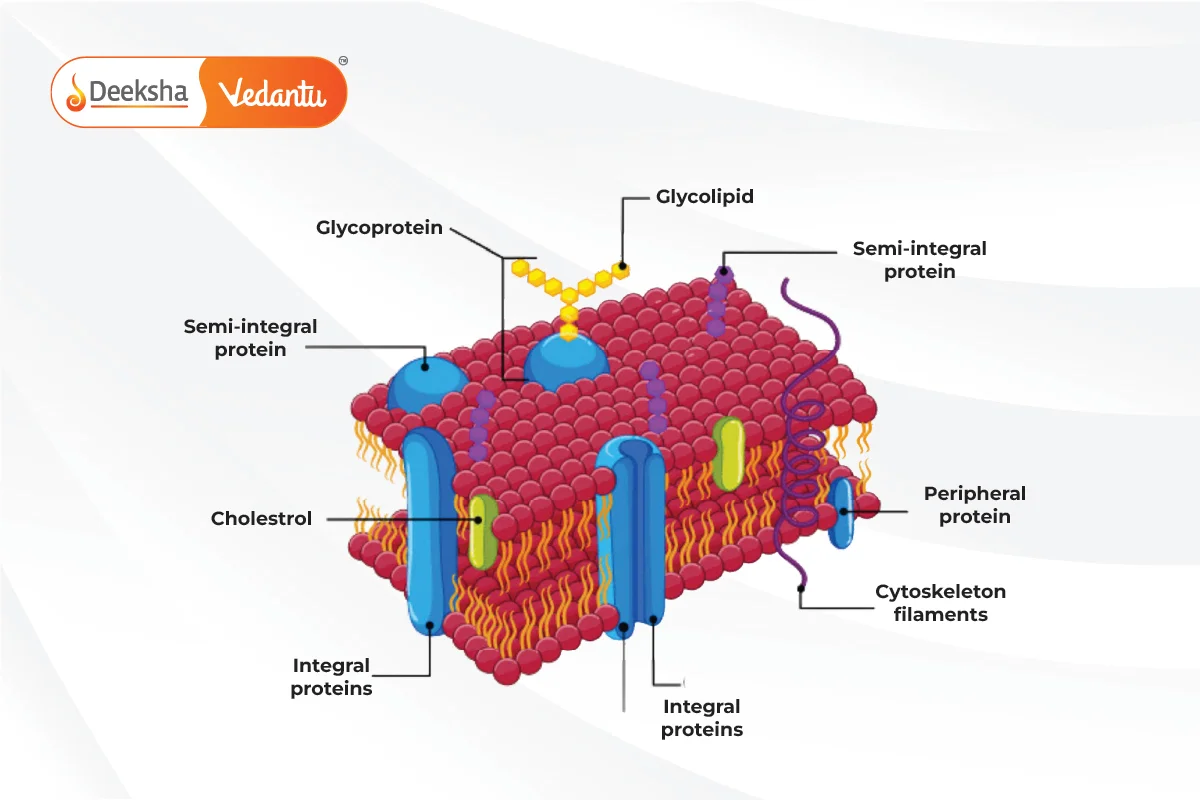What Is the Plasma Membrane?

The plasma membrane, also known as the cell membrane, is the biological membrane that separates the interior of all cells from the outside environment. It is a selectively permeable lipid bilayer found in all cells, forming a protective barrier between the cell’s internal and external environments. It is crucial in maintaining the integrity of the cell and in regulating the movement of substances in and out. In plant and bacterial cells, the plasma membrane is connected to a rigid cell wall on its exterior.
The plasma membrane is primarily composed of a lipid bilayer that is semipermeable, controlling the passage of various materials. This membrane also contains embedded proteins that assist in transport, enzymatic activity, and structural support.
Components of the Plasma Membrane
The plasma membrane’s structure is detailed by the fluid mosaic model, which describes it as a mosaic of components, including:
- Phospholipids: Form the fundamental structure, creating a lipid bilayer. Each phospholipid has a hydrophilic (water-attracting) phosphate head and two hydrophobic (water-repelling) fatty acid tails, which align to form a bilayer in aqueous environments.
- Peripheral Proteins: Attach loosely to the inner or outer surface of the membrane, often functioning as enzymes or in cellular communication.
- Cholesterol: Interspersed among the phospholipids, cholesterol molecules play a critical role in maintaining membrane fluidity. At high temperatures, cholesterol stabilizes the membrane and raises its melting point, whereas at low temperatures, it prevents the membrane from becoming too rigid by disrupting the regular packing of phospholipids.
- Carbohydrates: Attached to proteins (glycoproteins) or lipids (glycolipids) on the extracellular surface, playing a key role in cell recognition and interaction.
- Integral Proteins: Embedded within the lipid bilayer, some span the entire membrane and function as channels or transporters.
Structure and Function of the Plasma Membrane
The plasma membrane’s phospholipid bilayer is composed of hydrophilic (water-attracting) heads and hydrophobic (water-repelling) tails. This arrangement allows the membrane to be fluid and flexible, creating a dynamic barrier that can adapt to various cellular processes.
The fluid mosaic model, proposed by S.J. Singer and Garth Nicolson in 1972, illustrates the plasma membrane as a dynamic structure with components like proteins and cholesterol moving laterally within the lipid bilayer. This fluid nature enables the membrane to self-heal after minor damage and to allow proteins and lipids to diffuse, facilitating processes like cell signaling and membrane transport.
Key Functions of the Plasma Membrane:
- Protection and Structural Support: Maintains the cell’s integrity and protects its contents.
- Regulation of Transport: Controls the movement of substances in and out of the cell, maintaining homeostasis.
- Cell Communication: The plasma membrane contains receptors, such as G-protein coupled receptors, that facilitate cellular signaling and interaction with the external environment. These receptors can bind specific molecules like hormones or neurotransmitters, triggering internal cellular responses.
- Anchoring Cytoskeleton: Provides attachment points for the cytoskeleton, aiding in maintaining cell shape and facilitating intracellular transport.
- Selective Permeability: Only specific molecules can pass through, depending on factors like size, charge, and solubility.
Detailed Composition and Models
Lipid Bilayer Function:
- Barrier Formation: The lipid bilayer acts as a barrier, preventing the free passage of hydrophilic molecules while allowing lipid-soluble molecules to diffuse through. This selective permeability is crucial for maintaining the cell’s internal environment and is facilitated by the hydrophobic core of the lipid bilayer.
- Ion Regulation: The membrane’s impermeability to ions means that ions must pass through specialized channels or be transported via active mechanisms, enabling the cell to regulate its internal ionic composition and osmotic balance.
Proteins in the Plasma Membrane:
- Integral Proteins: Serve as channels or carriers for molecules that cannot diffuse freely. For example, aquaporins are integral proteins that specifically facilitate the transport of water molecules across the plasma membrane.
- Peripheral Proteins: Often involved in signaling pathways and maintaining the cell’s shape. These proteins may interact with the cytoskeleton to stabilize the cell membrane’s shape or with other proteins to relay signals received from the environment.
Carbohydrates in the Plasma Membrane:
- Glycoproteins and Glycolipids: Involved in cell recognition and signaling, forming the glycocalyx, which helps cells interact with their environment. The glycocalyx not only provides a protective barrier but also plays a crucial role in immune response by enabling the recognition of self and non-self cells.
Fluid Mosaic Model:
- This model suggests that the plasma membrane is not a static structure but rather a fluid, dynamic system where lipids and proteins can move laterally within the layer. This fluidity is essential for functions like membrane fusion during vesicle transport, cell division, and cell signaling.
Endocytosis and Exocytosis:
- Endocytosis is the process by which the plasma membrane engulfs external substances, forming a vesicle that brings the substances into the cell. Phagocytosis (cell eating) and pinocytosis (cell drinking) are examples of endocytosis. Exocytosis is the opposite process, where vesicles within the cell fuse with the plasma membrane to release their contents outside the cell. These processes highlight the dynamic nature of the plasma membrane and its role in material transport.
Signal Transduction:
- The plasma membrane is central to signal transduction, where receptors on the membrane bind specific signaling molecules, triggering a cascade of intracellular events that lead to a response. For example, the binding of a hormone to its receptor on the plasma membrane can activate a series of proteins inside the cell, ultimately influencing gene expression or metabolic pathways.
Plasma Membrane and Disease:
- Abnormalities in plasma membrane proteins or lipids can lead to various diseases. For instance, cystic fibrosis is caused by mutations in the CFTR protein, a chloride channel in the plasma membrane, leading to thick mucus production in the lungs. Similarly, certain cancers involve overactive growth factor receptors on the plasma membrane, promoting uncontrolled cell division.
Therapeutic Targeting:
- Many therapeutic drugs are designed to interact with plasma membrane components. For example, antihistamines block histamine receptors on the plasma membrane, reducing allergic responses. In cancer treatment, drugs may target specific receptors to block signaling pathways that promote tumor growth.
FAQs
Selective permeability is crucial because it allows the cell to maintain homeostasis by controlling the entry and exit of substances, ensuring the internal environment remains stable and suitable for cellular functions.
The fluid mosaic model is a scientific description of the plasma membrane structure, depicting it as a dynamic and fluid combination of lipids, proteins, and carbohydrates that move laterally within the layer.
The plasma membrane maintains fluidity through the presence of cholesterol among the phospholipids and the unsaturated fatty acid tails of phospholipids, which prevent the membrane from becoming too rigid.
The plasma membrane is composed of phospholipids, cholesterol, integral and peripheral proteins, and carbohydrates.
The main function of the plasma membrane is to protect the cell by forming a barrier between the cell’s internal environment and the external environment. It regulates the transport of materials, facilitates cell communication, and maintains the cell’s structural integrity.
Related Topics
- Important Notes For NEET Biology – Morphology of Flowering Plants
- Important Notes For NEET Biology – Breathing and Exchange of Gases
- Plasmid
- Important Notes For NEET Biology -Shapes of Bacteria
- Marchantia
- Types of Fermentation
- DNA Polymerases
- NEET Biology Weightage
- Paramecium
- Plant Hormones
- Important Notes For NEET Biology – Body Fluids and Circulation
- Bryophytes
- Nostoc
- Important Notes For NEET Biology – Anatomy of Flowering Plants
- Connective Tissue







Get Social